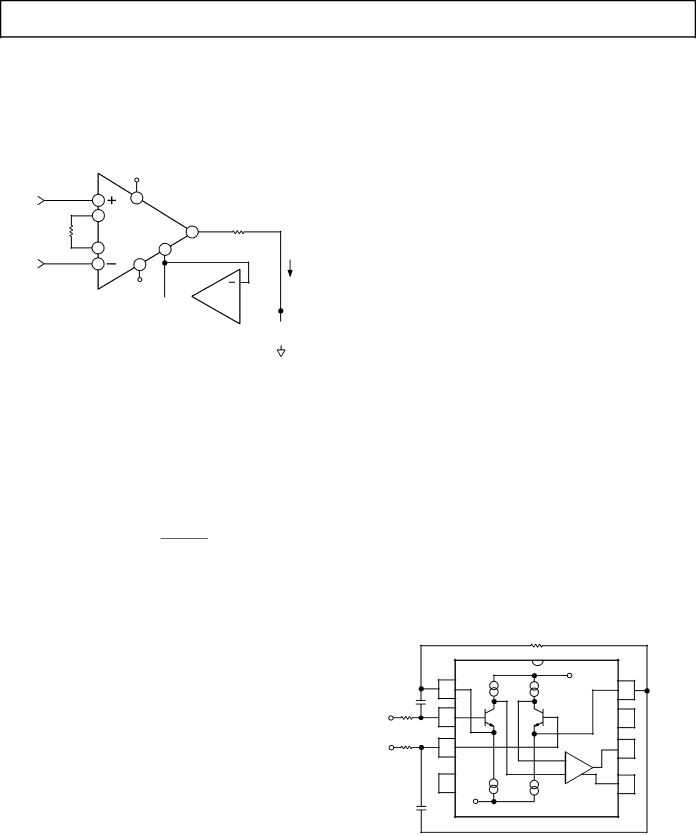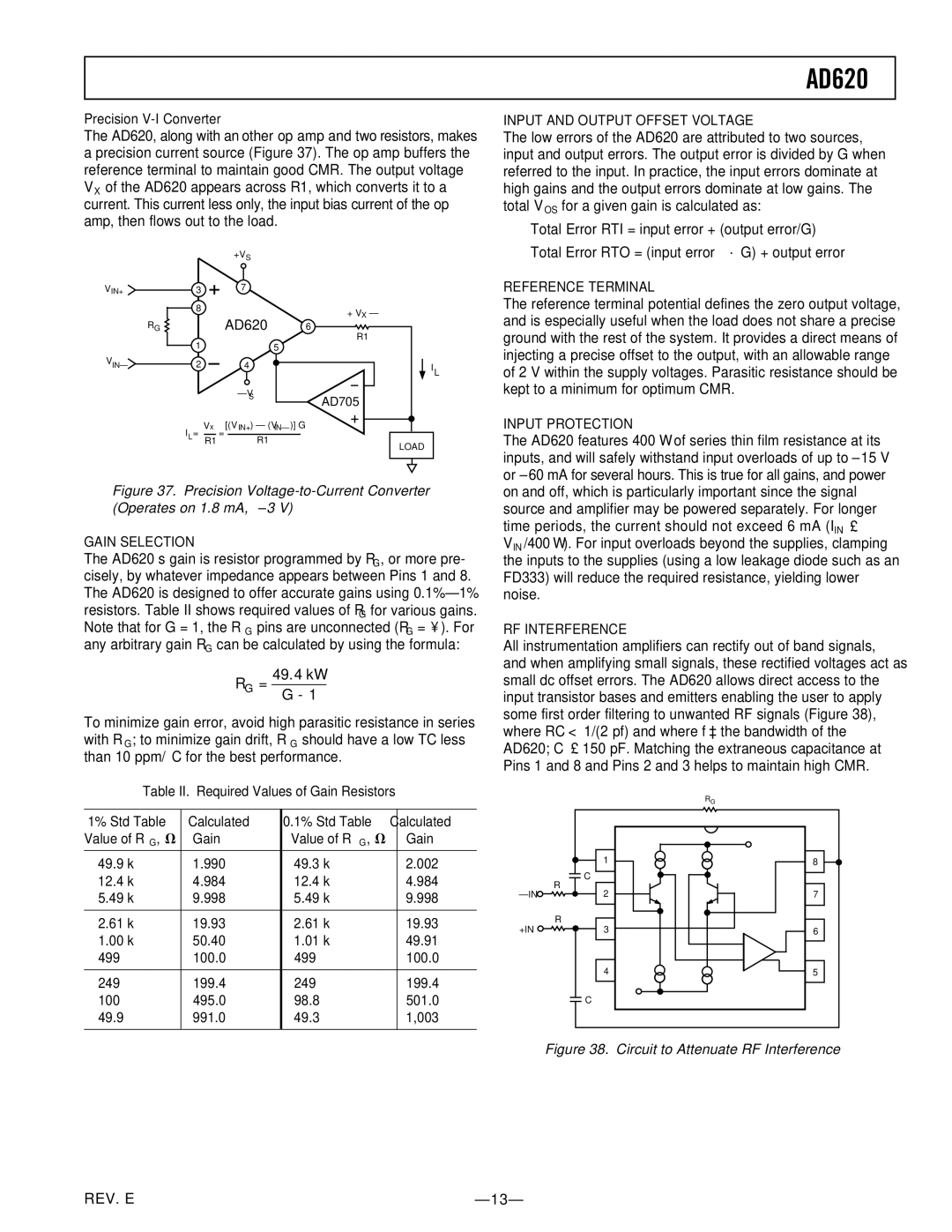
AD620
Precision
The AD620, along with another op amp and two resistors, makes a precision current source (Figure 37). The op amp buffers the reference terminal to maintain good CMR. The output voltage VX of the AD620 appears across R1, which converts it to a current. This current less only, the input bias current of the op amp, then flows out to the load.
|
| +VS |
|
VIN+ | 3 | 7 |
|
| 8 |
| + VX – |
| RG | AD620 | |
| 6 | ||
| 1 |
| R1 |
|
| 5 | |
VIN– | 2 | 4 | IL |
|
|
|
|
|
|
|
|
|
|
|
|
|
|
|
|
|
| |||
|
|
|
|
| S |
|
|
| AD705 | ||||||||
|
|
|
|
|
|
|
|
|
| ||||||||
| Vx |
| [(V |
| ) – (V )] G |
|
|
|
| ||||||||
|
|
|
|
|
|
|
|
|
| ||||||||
I = |
| = |
| IN+ |
| IN– |
|
|
| ||||||||
L | R1 |
|
|
|
| R1 | LOAD | ||||||||||
|
|
|
|
| |||||||||||||
|
|
|
|
|
|
|
|
|
|
|
|
|
|
|
| ||
|
|
|
|
|
|
|
|
|
|
|
|
|
|
|
|
|
|
Figure 37. Precision Voltage-to-Current Converter (Operates on 1.8 mA, ±3 V)
GAIN SELECTION
The AD620’s gain is resistor programmed by RG, or more pre- cisely, by whatever impedance appears between Pins 1 and 8. The AD620 is designed to offer accurate gains using
=8>28 Ω
−5
To minimize gain error, avoid high parasitic resistance in series with RG; to minimize gain drift, RG should have a low
Table II. Required Values of Gain Resistors
1% Std Table | Calculated | 0.1% Std Table | Calculated |
Value of RG, V | Gain | Value of RG, V | Gain |
49.9 k | 1.990 | 49.3 k | 2.002 |
12.4 k | 4.984 | 12.4 k | 4.984 |
5.49 k | 9.998 | 5.49 k | 9.998 |
|
|
|
|
2.61 k | 19.93 | 2.61 k | 19.93 |
1.00 k | 50.40 | 1.01 k | 49.91 |
499 | 100.0 | 499 | 100.0 |
|
|
|
|
249 | 199.4 | 249 | 199.4 |
100 | 495.0 | 98.8 | 501.0 |
49.9 | 991.0 | 49.3 | 1,003 |
|
|
|
|
INPUT AND OUTPUT OFFSET VOLTAGE
The low errors of the AD620 are attributed to two sources, input and output errors. The output error is divided by G when referred to the input. In practice, the input errors dominate at high gains and the output errors dominate at low gains. The total VOS for a given gain is calculated as:
Total Error RTI = input error + (output error/G) Total Error RTO = (input error × G) + output error
REFERENCE TERMINAL
The reference terminal potential defines the zero output voltage, and is especially useful when the load does not share a precise ground with the rest of the system. It provides a direct means of injecting a precise offset to the output, with an allowable range of 2 V within the supply voltages. Parasitic resistance should be kept to a minimum for optimum CMR.
INPUT PROTECTION
The AD620 features 400 Ω of series thin film resistance at its inputs, and will safely withstand input overloads of up to ± 15 V or ± 60 mA for several hours. This is true for all gains, and power on and off, which is particularly important since the signal source and amplifier may be powered separately. For longer time periods, the current should not exceed 6 mA (IIN ≤ VIN/400 Ω). For input overloads beyond the supplies, clamping the inputs to the supplies (using a low leakage diode such as an FD333) will reduce the required resistance, yielding lower noise.
RF INTERFERENCE
All instrumentation amplifiers can rectify out of band signals, and when amplifying small signals, these rectified voltages act as small dc offset errors. The AD620 allows direct access to the input transistor bases and emitters enabling the user to apply some first order filtering to unwanted RF signals (Figure 38), where RC < 1/(2 πf) and where f ≥ the bandwidth of the AD620; C ≤ 150 pF. Matching the extraneous capacitance at Pins 1 and 8 and Pins 2 and 3 helps to maintain high CMR.
|
| RG |
| 1 | 8 |
| C |
|
| R |
|
2 | 7 | |
+IN | R |
|
3 | 6 | |
| 4 | 5 |
| C |
|
Figure 38. Circuit to Attenuate RF Interference
REV. E |
